About eight years ago, bumming around Kansas City one day, I ventured into an antique store wherein I found one of those happy little treasures – a complete set of vintage table linens, including a table runner, what I think must be a tea tray liner or sideboard cloth (larger than a placemat, but not long and narrow like a table runner), eight placemats, eight napkins. They were an oatmeal-ish color and in very good condition. I liked their simplicity, and I liked the drawn thread work and embroidery that adorned them. And the price was actually very good. They were asking $60 for the set, so I thought it would be All Wrong just to leave them there. I almost felt morally obliged to take them home! Heck, I just like vintage linens. I didn’t really need to convince myself…. (Are you with me?)
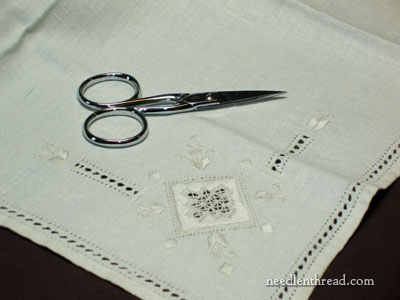
Well, it so happens that, recently, through a reliable online seller, I came across a collection of five vintage table napkins (one of which is pictured above) that were being sold as Lefkara lace. I recognized similarities between this set of five napkins and the set I had purchased in KC years before, so I purchased them in order to be able to compare the linens.
That’s the background information. Here are pictures of both sets of linens, focusing mainly on the embroidered motifs and the small areas of drawn thread work. I’m not really certain whether or not one or both or neither are definitely Lefkara lace, but the drawn thread areas do have that look, and I just like the linens. What do you think? Lefkara, or no? If you’re familiar with Lefkara techniques, you’ll probably know better than I would!
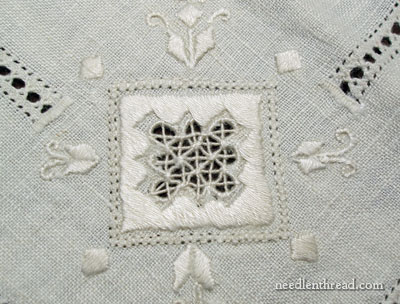
This is from the most recent set purchased, of five linen napkins sold as Lefkara lace. There isn’t a lot of needlework on each piece; just one corner is adorned as above, with the drawn thread square in the middle and the geometric figures on the side. The square is further outlined with a Four-sided Stitch edge and then surrounded with little geometric motifs, and there are two short drawn thread strips that match the outer decorative edge.
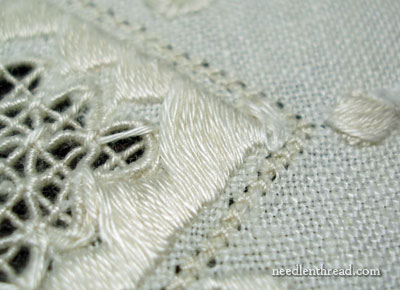
This photo is actually of the back of the linen – you can see how time has really relaxed the threads. They undulate softly. The thread looks like coton a broder to me.
So that’s what the napkins sold online as vintage linens with Lefkara lace look like.
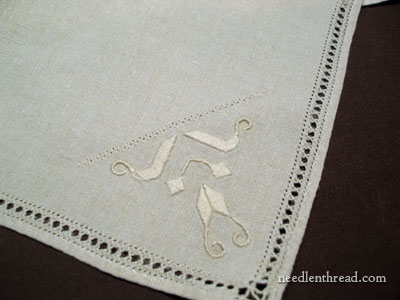
This is the corner of one of the cloth napkins that I bought in KC eight years ago. On the napkins, the only adornment is this geometric figure embroidered in the corner, with a small strip of four-sided stitch underneath it.
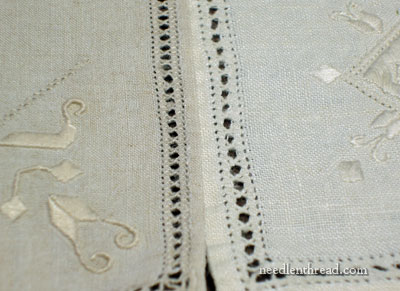
The linen on the left is the KC linen from 8 years ago; the linen on the right is the one I bought recently online. The edges are the same.
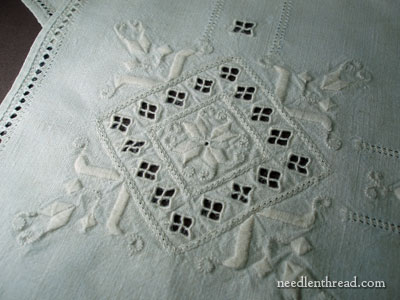
This the table runner from the KC linens, from the back of the linen. (I always look at the back of linens that are sold as hand embroidered – it’s much easier to verify that they are hand embroidered). You can see the cutwork diamond areas here – not quite the same as the drawn thread “grid” on the more recently purchased napkins, but still slightly similar, with the wrapped bars. And of course, there’s the whole geometric motif thing going on.
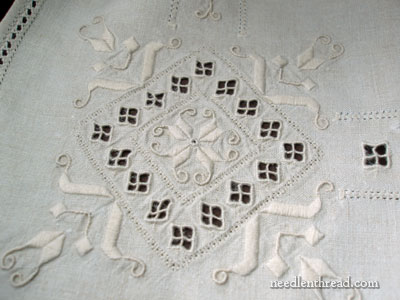
Here’s the front of the same motif.
Both sets of linen are similar in overall look and style, though when you get down to the details, they aren’t identical.
I have the book “Lefkara Lace Embroidery: Historical Development, Designs, & Techniques” by Androula Hadjiyiasemi, but I’ve never actually read the book. Time to get it out and do some exploring!
What about you? Do you like vintage linens? Do you need someone to twist your arm if you come across nice ones (that are affordable for you) in antique stores and so forth? Big point of curiosity: If you are a vintage linen connoisseur, what do you do with yours? Do you use ’em? Or store ’em? (I’m of two minds on that question – more on that topic later!)







Hi Mary,
I actually have a set of inherited linens which may be Lefkara lace, too. They have the horned embroidery and some needle lace. They do say that Cypriots used to travel to the U.S. to sell their work.
I sometimes visit antique stores just to see if they have handkerchiefs with nice needlework. They aren’t expensive, and they are great references. As for using them, I will as long as they are still in good shape. Why not get the maximum fun out of them? If they are too fragile, or get that way, I use them for display only (on tables, etc.) or just keep them for reference and enjoyment. It’s sad when something shreds when you wash it, but I figure as long as I have it, I have the option of recreating it with fresh new materials!
If only they came with notes on when they were made, how long it took, materials, etc., right?
Hi Elissa – Oh yes, notes would be nice!! Where they were made would be a nice thing to know, too. I pretty much do the same thing you do: use them, but not always as their intended purpose – cloth napkins, for example, or handkerchiefs become doilies or accent linens, and larger cloths become table centers, buffet cloths, dresser scarves – things like that. If they are too worn, I store them, study them, photograph them and use them for reference and design ideas. ~MC
I love vintage linens. I usually use them or convert them into something else. Like vintage handkerchiefs can become a pillow cover or pocket on a skirt, etc. I can’t see buying something to just to sit around – I like things to be useful.
I have a few pieces of linen with very similar patterns on them that I too bought in an antique shop very reasonably. On close inspection, I think they are Chinese machine made repros of Lefkaritika, but I could be wrong. I have a luncheon sized cloth and a rather short wide ‘runner’ that I assume is for a sideboard. Sorry I don`t have pics and the cloths are in Canada awaiting me moving my household goods to Colorado this fall….
I am not even sure how to respond — do I like vintage linens? you bet! arm twisting? NEVER! quite the opposite. I have to be quite stern with myself to NOT buy everything I see! I feel obligated to take home, care for, and appreciate hand worked embroidery. An orphanage, so to speak! The only way to control myself is to NOT look. I have always found handkerchiefs to be wonderful samplers of all styles of hand embroidery — and so inexpensive. Hand towels, table clothes, household linens, anything monogrammed,or clothing. And once you see a piece that you KNOW took someone many, many hours to embroider and it is being sold so inexpensively! Well, you get the picture. And as I learn more, I go through my boxes and fine splendid examples that I didn’t even know what they were (other than “beautiful”). In my next trip through I am searching out Lefkara. Thank you for the education, Mary.
I’m not a vintage linen collector, but I have a lot of it that belonged to my mother and my grandmother. I use it for its intended purpose (except handkies) and enjoy it.
I love antique linens and embroidered antique clothing. The linens are usually more affordable than the clothing. I have some of the linens out as decorative accents. The clothing which is mostly baby items are displayed. I buy items that talk to me. I will look and then after shopping a little if I can hear them calling me I go back and get them.
I like to study them and think about the women who worked so hard making the pieces without all the great equipment we have today. Especially the good lighting. DP
Someone has to tie my arms to keep me from buying things like these!!!LOL…your purchases are lovely – use them in good health. I also use them for study…if only I had the time to copy them!
Hi Mary,
Great thoughts about Lefkara lace. I am new to this and can’t give you any information about it, but I LOVE your site! Where else can I get my needle and thread fix as well as wonderful writing. I love starting the day with words like “wherein”…in the first sentence, no less. :-] My sons and I used to play with words all the time when they were young, and one of them majored in creative writing in college. So cool.
Hey Mary,
They look very much like Hardanger to me, but I’m not sure what the technical differences there are between the two styles of embroidery. Hardanger uses the same cutwork, drawn thread and geometric motifs. The edging looks very much like some of the stitches I’ve used for hardanger. I would say that lefkara and hardanger share the same root, though which came first, I couldn’t say.
Just my two cents.
Keli
I heard the term Lefkara when you mentioned it for the first time and your linen pieces are fabulous. I have inherited some needlework from my mother-in-law which I proudly display in my home. There are pieces, which are now just stored so that I can show my daughter from time to time.
Mary,
They could be Lefkara lace, but I also know that there is a large Danish community in SW Iowa and NE Missouri and these ladies still do hardanger pulled thread embroidery as well. I am not an expert in either one, but these linens look much like those i saw in my home county growing up in SW Iowa. Regardless of which type, I also enjoy these pieces and I struggle with use or store and show them, but As I get older I am leaning more to use. If I enjoy them I know that the rest of my family does not have my passion for them and they will end up in the antique bin and not in my family’s hierloom trunk. I also am enjoying making quilt blocks out of some of them as well, which also uses them, but in a different way.
Could it be Hardanger?
I am no expert, but may your beautiful linen be stitched with Punto Antico,a simpler, perhaps more elegant style than Lefkara?
I absolutely adore antique linens, and feel it is my obligation to save them from an unappreciative public. Last year I had an absolutely wonderful find at a garage sale…a complete set of thick cotton sheets, with tatted lace trim, a 24″ lovely knit circular doily and some other items. Just lovely and total price was $3.00. I told the seller how valuable they were, but she said they had been in her mothers trunk in the attic for 40 years and she wanted them to be used. I as so very grateful for them. As for what I do with my vintage linens. I use them unless they are too fragile. I love sleeping in my wonderful “new” sheets, and use the doily on my dining room table. There are some antiques that should be conserved, but most of the ones that come my way are not of that category and I use them; thankful they have come to me and appreciating all the work that went into their creation.
I don’t generally use the linens I have inherited from my grandmother (mainly because I can’t be bothered trying to keep them looking pristine). I do, however, quite often cut them up and use them as design elements in my crazy quilts…especially if they’re ones that are a bit worn or stained.
I have never even heard of Lefkara. I’m a simple embroiderer. But those linens are BEAUTIFUL. I love vintage linens and have several. I always buy linens when antiquing or at an estate sale. I have never met a vintage “linen” I didn’t like. 🙂
I agree with the others- Hardanger in spirit, especially the diamond shaped “flowers”; one of the foundations of Hardanger. The biggest difference that I can see is that Hardanger is strictly counted, but Lefkara is not so strict. It’s got split floche, too, resembling Encroaching Satin Stitch.
I’m with Erica on this one, sure looks more like Punto Antico than Lefkara…
http://www.florin.ms/Dscn0756.jpg
What an interesting topic this one is. I agree with the comment about Mary’s language: it is extremely gratifying to me (a linguistic Anglophile) when other people use the language well.
I know little about either Lefkara or Hardanger although I have seen quite a bit of the latter. To my eye, these beauties are probably not Hardanger. However what would I know, beyond that they are drop dead gorgeous.
I don’t buy seriously wonderful antique linens but I do look out for small items like doileys and handkerchiefs which, like Mary Anne, I cut up for crazy quilting.
To continue on Erica’s point, the raised work on these linens reminds me of the motifs on this punato antico biscornu (a pattern I first learned of from your site): http://www.interweave.com/needle/projects/Punto-Antico-Biscornu.pdf
Hi Mary,
I absolutely adore vintage linens! In fact, I have to keep away from the antique malls because I always spend toooo much money. I have a few that look very much like what you are showing in this post. I really don’t understand exactly what Lefkara is, but later in the week I’ll try to photograph my linens and post them so you can see. I do try to use my linens occasionally, generally for bridal or baby showers (not nearly enough of those!). I do have some in a china cabinet that are draped over the front to show off the embroidery.
Hi Mary
These look more like Punto Antico to me – mostly because of the peahole stitch borders.
I have picked up a number of nice pieces of vintage tablelinens and I do display them. I wouldn’t let anybody have dinner over them though.
~Pam
I love old linens so much that I’m fascinated by your Lefkara lace articles in the hopes of someday replacing a beloved vintage lace table-topper that I lost in my last move.
I had always assumed it to be Hardanger, and have done some Kloster blocks that looked a lot like the openwork, but now realize it was probably Lefkara Lace on the basis of the long satin-stitched motifs on the areas that weren’t cut away.
And, just to add even more confusion, I agree with Debbie Thompson that your linens might be Danish-American in origin. Hedebo is a form of Danish whitework that echoes Venetian embroidery by creating holes in fabric, then filling them with beautiful needle lace such as you show in your third picture. Your wonderful camera work makes it clear that this openwork is created on the bias, so the openwork can’t be Kloster blocks. The whitework sections are similar to Lefkara, but they seem to have a sheen that my table-topper didn’t.
For years, I was convinced that modern Hardanger workers were using the wrong materials in preferring pearl cotton for designs that were, in my mind, better suited to a matte cotton, based on my table-topper. Now, seeing Lefkara lace, I realize the preference for low-sheen thread on linen is another distinguishing factor for the lacework.
Those linenes are really pretty and I’m sure they are made in Punto Antico embroidery. I did something similar many years ago.
The pulled thread surrounding border is worked with a stitch called Gigliuccio.
On Google image is possible to see many similar works typing Punto Antico.
Mary,
Thank you for the two posts on Lefkara. The lace is beautiful and I had never before thought to identify it as a special style. I learn so much from your posts. I have ordered several books because I have seen them evaluated on your blog and then gone on to do further research.
This particular book, however, I would not purchase for that price because I would never attempt learning to stitch that style of embroidery. My eyes can’t handle counting that fine linen. It is too expensive for my research library.
Thanks for the thorough review of the differences between lefkara and hardanger. The curved lines do enhance the design and clearly differentiate it, as you say.
I bought new Lefkara lace from the the Lefkara village and was told by the lace maker there that all pieces of Lefkara lace had the same edging, and yours is not that design. I am away at the moment so can’t load a picture to show you.
Your linens are lovely, by the way!
Hi Mary;
I just bumped into this page. It looks like Lefkara Lace to me. My dad was born in Pano Lefkara and all his sisters and mom sat for many, many hours making the lace. We used to have a big boxful but alas it was stolen during a move (only 1 of 282 boxes was targeted.
I enjoyed your site
regards
Lou G
Hi again;
I just saw these omments and Lynn Sivill may be correct. I have some pieces left that my dad brought us and I will check to see if Lynn is correct. Several of the Pano Lefkara shopkeepers lived on my dad’s street, and one who has 2 shops lived direwctly next door. Next time I see Marina, I will ask.
Cheers
Lou G